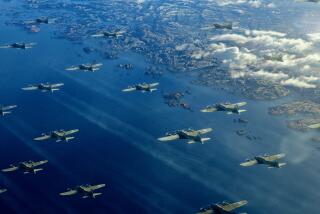Daredevils’ Playground : Experimental and Stunt Pilots Have Called Flabob Airport Home and Struggle to Keep Its Tradition Flying
RIVERSIDE — Rick Loomis remembers his ignominious introduction 40 years ago to the scrappy, little, river-bottom airstrip with the funny name, Flabob Airport.
*
As a 5-year-old, he was sitting atop a gasoline can in the front seat of an open cockpit biplane to improve his view, and when his father veered hard for the landing, the tank shifted and jammed the control stick. His father lost control of the biplane, which rammed the airstrip on its nose, then flipped and slid down the runway upside-down.
But the experience--and the soul and spirit of Flabob Airport--seems to have emboldened Loomis. Today, he and his wife, Janice, are building their own airplane at Flabob so he can fly aerial stunts--with her standing on the wing.
And so it goes at Flabob Airport, perhaps Southern California’s grittiest collection of experienced aviators, dilapidated hangars and custom-built airplanes.
The privately owned, public-use airport has no control tower, a rather bumpy, 3,200-foot-long asphalt runway and just one really important rule: Keep your dogs leashed so they don’t meander out on the runway.
But it enjoys a worldwide reputation among aviators who respectfully call the place “Flabob International.” They come from Australia, from South Africa, from Germany and from Japan to experience for themselves the history that has been chalked up over 52 years.
It is home to Chapter No. 1 of the Experimental Aircraft Assn. Ray Stits built Sky Baby--at 9 feet, 10 inches long the world’s smallest airplane--here in 1952. Stunt pilot Art Scholl started his aerobatics school here. Pilot and war-bird collector Frank Tallman built and restored aircraft here. Hollywood has tapped Flabob’s pilots and airplanes for such movies as “The Great Waldo Pepper,” “The Rocketeer” and “Top Gun.”
The old hangars house airplanes that conjure dreams for old-time aviators: replicas or restored originals of such aerial hot rods as the DH-88 Comet, the Miles-Atwood, the Miss Los Angeles, the Pete and the Gee Bee.
Just as vital to Flabob’s reputation is the stock of aviators who hang out--ranging from World War II aces to F-14 pilots.
“As soon as I discovered the place, I fell in love with it,” said Pat Halloran, a retired Air Force general who flew the SR-71 and U-2 spy planes. “It’s not just the camaraderie the likes of which I’ve never seen elsewhere, but Flabob has retained the appearance and charm of an early airport.”
Flabob evolved out of an old Civil Air Patrol airstrip, sandwiched alongside the Santa Ana River and Mt. Rubidoux not far from downtown Riverside.
At the close of World War II, two Los Angeles men--flier Flavio Madariaga and investor Bob Bogen--looked around Southern California to buy their own airstrip and settled upon the 80-acre Riverside site because the land was cheap and undesirable. They named the airport after themselves.
Strapped for cash, Madariaga began wheeling and dealing for construction material. He bartered his own plane--and flying lessons--for old lumber and acquired a burro, plow and wagon so he could masquerade as a farmer and qualify for free surplus buildings being discarded at March Air Force Base.
Building hangars that looked aged even before they were erected, and renting them out dirt-cheap, Madariaga soon enticed other flying buddies from Los Angeles to relocate, and Flabob soon was home to an eclectic collection of old warplanes, antiques, home-builts and small factory-builts known as “Spam cans.”
Because of his reputation as a charismatic flight instructor par-excellence, pilot wanna-bes from all over came to Flabob to learn how to fly from Madariaga and to rub shoulders with aircraft designers and stunt pilots who adopted Flabob as their base of operations.
But the spirit of Flabob was lost forever, some say, when Madariaga and his wife, Bertha Ann, were killed at the airport 11 years ago this month. The couple crashed into a neighboring cow pasture just after taking off in their twin-engine Piper. Federal crash investigators concluded that Madariaga forgot to remove a theft-control device he had installed the day before, and lost control moments after takeoff.
“He meant so much to everyone--he was this airport--the crash just took aviation out of everyone’s heart,” said his son, Don Madariaga, who manages the airport on behalf of theheirs of both founding men. “It took a while for people to start flying again.”
The airport has regained most of its spirit, but the families of the two founders would just as soon sell the place, Madariaga said.
“But it’s been pretty hard, finding the right kind of person who will respect the nostalgia and bring the love to Flabob that my father did,” Don Madariaga said.
But the pilots who still hang out here, who baby the 150 planes that make Flabob their home port, say there is still no better place.
“To work on airplanes here is to step back 30, 40 or 50 years in time,” said Ed Gudde, a machinist who has had his hands in the restoration of half a dozen race planes. “There’s a legacy here that most airports couldn’t begin to relate to.”
More to Read
Sign up for The Wild
We’ll help you find the best places to hike, bike and run, as well as the perfect silent spots for meditation and yoga.
You may occasionally receive promotional content from the Los Angeles Times.





